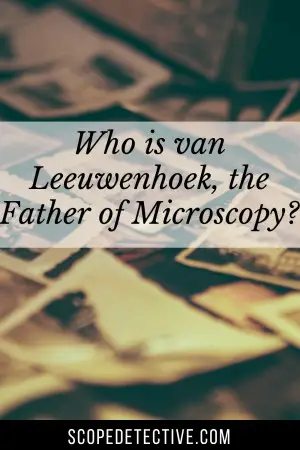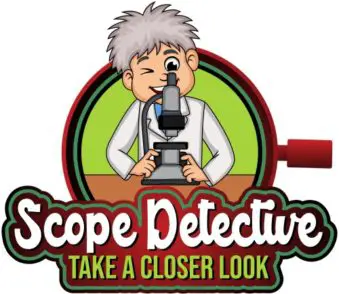 It’s a common misconception that van Leeuwenhoek invented the microscope, but microscopes were around for about 40 years before van Leeuwenhoek was born.
It’s a common misconception that van Leeuwenhoek invented the microscope, but microscopes were around for about 40 years before van Leeuwenhoek was born.
Nonetheless, we still consider van Leeuwenhoek to be the father of microbiology and even the father of microscopy because of the remarkable developments he made in microscopy.
Born in 1634, van Leeuwenhoek lived in the Netherlands during the Golden Age of Dutch science and was a leading amateur scientist of the era. Like many of his time, he was a self-taught scientist who pushed the boundaries of scientific thought.
He is primarily remembered for his microscopes and his observations of microbes.
He was first to record observations of:
- Unicellular organisms
- Muscle fibers
- Bacteria (he called them “little animals”)
- Spermatozoa
- Red blood cells
- Blood flow through capillaries
For these observations and recordings, van Leeuwenhoek is now known as the ‘father of microbiology’.
> This article is from my series on the History of Microscopy
Anton van Leeuwenhoek (The Father of Microbiology)
Anton van Leeuwenhoek lived to the ripe old age of 90 and by his death in 1723, he had made many significant scientific discoveries.
1. Early Life
Van Leeuwenhoek had a tumultuous childhood. He was born in Delft in the Netherlands to a basket weaver father and a mother from a wealthy family of brewers. He had four older sisters.
When he was just 5 years old, Van Leeuwenhoek’s father died, and his mother subsequently remarried a painter, who then went on to die when he was just 10 years of age. In his teens, Van Leeuwenhoek was sent to live with his uncle, who he stayed with until he left for Amsterdam at the age of 16.
Van Leeuwenhoek had a career as a linen draper. He worked as an apprentice for several years before opening up his own shop in Delft in 1654.
He married his first wife Barbara de Mey in 1654 and they remained married until her death in 1666. Together they had one daughter. He subsequently remarried Cornelia Swalmius in 1671.
2. Interest in Microscopy
Van Leeuwenhoek developed his interest in microscopy when he needed a closer-up look at the threads in his linen shop.
In order to get clear close-ups of his thread, van Leeuwenhoek developed his own ocular lenses, which turned out to be some of the most advanced of his time.
Van Leeuwenhoek was very secretive about his methods of lens making. It is speculated that he learned his methods from passages in Robert Hooke’s Micrographia, which he may have encountered on a visit to London in 1668. However, van Leeuwenhoek could not read in English, so this is speculation at best.
Nevertheless, today it’s widely believed he created his lenses by melting down glass rods, pulling at them until they were thin strings of glass, then holding the end of the fine string against a flame to create a glass sphere.
In general, the smaller the sphere, the better quality the magnification would be.
3. Development of the van Leeuwenhoek Microscope
Van Leeuwenhoek’s microscopes were rather rudimentary implements containing just a single lens. Even for the time, his microscopes were only noteworthy for the quality of that single lens and not the complexity of design.
In fact, the compound microscope – a microscope with multiple lenses – had existed for many years before he came around and was somewhat more complicated in its design than van Leeuwenhoek’s designs.
Nevertheless, with his very finely designed pearl lenses, van Leeuwenhoek was still able to make observations that were advanced for his day. While compound microscopes of the day were able to achieve magnification of about 20x, his microscopes could magnify up to 200x.
Alongside the superior magnification, van Leeuwenhoek was astute at using natural lighting to improve the quality and contrast of his observations.
He made over 500 microscopes in his time, but unfortunately only about 10 of his original microscopes exist today.
FAQ: When did van Leeuwenhoek invent the Microscope?
Van Leeuwenhoek developed his first microscopes around 1668 by melting pearls of glass into small lenses. However, it is a common misconception that he was the inventor of the microscope. The compound microscope was in fact invented in the 1590s in Middelburg, Holland. Van Leeuwenhoek’s microscopes are notable because they had higher magnification than most that came before. His microscopes achieved up to 200x magnification despite being only single lens devices, enabling him to make detailed descriptions of bacteria for the first time.
4. Van Leeuwenhoek’s Discoveries
While he never penned a book, Van Leeuwenhoek wrote many letters to the Royal Society of London, a prestigious academy of sciences established in 1660. His first letter to the academy was in 1671, outlining his observations of bee stings. These letters were translated to English and published in the Philosophical Transactions of the Royal Society.
Through the years, he wrote to the Royal Society observations of specimens including:
- 1664 – Spirogyra, a green algae identified in water
- 1676 – Vorticella, a protozoa identified in water
- 1683 – Plaque and bacteria in teeth
- 1700 – Foraminifera (Hooke had identified these prior, in Micrographia)
Recognition as Father of Microscopy
Van Leeuwenhoek was never trained in scientific methods, but his observations were detailed and he identified many organisms that no one else had ever found.
Due to his lack of scientific training, many in the Royal Society were sceptical of his letters. A party was sent to investigate his claims, and it wasn’t until 1677 that the Royal Society finally fully accepted his works.
Today, he is widely respected as clear and authoritative early records within a field that would come to be known as “microbiology”, to the extent that he is widely known as the “father of microbiology”.
In 1680 (in recognition of his contributions to science), he was elected a full member of the Royal Society. He was said to have been surprised but highly honored by the nomination.
Conclusion
Today, it’s widely accepted that van Leeuwenhoek is both “the father of microscopy” and “the father of microbiology”. We continue to celebrate his findings and teach students about his amazing discoveries in science classes around the world.
Without the discovery of bacteria, we wouldn’t have made the huge health and hygiene improvements that have saved countless lives today.
Being untrained in science, he’s a hero amongst amateur scientists. He represents the inspired scientific mind of the at-home microscopy enthusiast.
With modern compound light microscopes, we can replicate van Leeuwenhoek’s experiments at home and in school science labs and imagine what it would have been like to have been the first person to ever identify these little creatures.
Hi, I’m Chris and I run things around here! I share all my microscopy experiments, microscope information and tricks, how to guides, and microscope reviews in the articles on this site. Browse around to see what you like (I recommend the experiment ideas section) or connect with me on any of the social platforms listed below.

